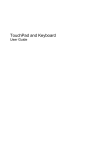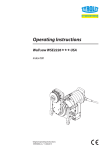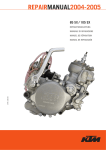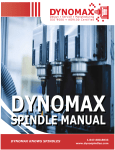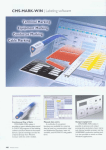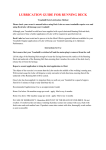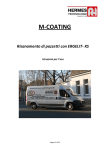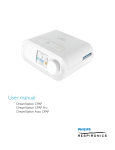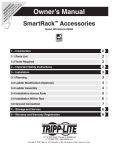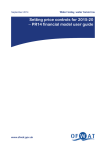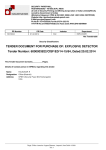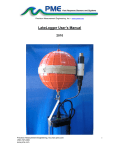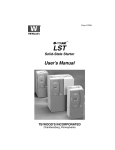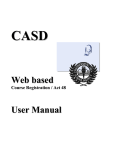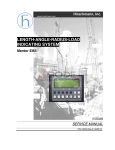Download QuickLock BIG User Manual
Transcript
QuickLock BIG User Manual Version 04/2014 Sold by: Rausch Electronics USA, LLC. 4757 Innovation Way Chambersburg, PA 17201 Service: (717) 263-8093 | Office: (717) 709-1005 | Fax: (717) 709-1009 | www.repipetech.com | [email protected] IMPORTANT DISCLAIMER: This manual is subject to change without notice. Updates can be obtained online at www.repipetech.com. This manual does not guarantee the product will work properly. Contact a RAUSCH Certified Installer to ensure proper installation. The following are important disclaimers to consider before using the QuickLock BIG system. 1. QuickLock BIG installations are to be performed only by trained and qualified personnel, using adequate and safe equipment. 2. Read and follow the instructions, as described in this manual before attempting installation. 3. Prior to beginning the installation, verify that all the equipment and components involved are undamaged and in proper working condition. 4. QuickLock BIG is designed for and must only be used in municipal sewer, storm sewer and potable water environment. For all other applications, please consult Rausch prior to use. 5. Do not use QuickLock BIG in broken pipes with protruding objects. 6. Verification of lines inner diameter / I.D. must be known as accurate as possible in order to ensure the correct sleeve is used. Refer to the Technical Data Sheet at the end of this manual. 7. If after reading this manual you have any questions or concerns, please contact Rausch USA. Version: 04/24/2014 2 Contents 1. About this document ............................................................................................... 4 1.1 Regulations ................................................................................................................... 4 2. Description of the QuickLock BIG system............................................................ 5 2.1 Intended use ................................................................................................................. 5 2.2 Components and functions ........................................................................................... 6 2.3 Description of the system and procedure .....................................................................7 2.4 Suitability and materials used ....................................................................................... 8 3. How to use the system ............................................................................................ 9 3.1 Preparation.................................................................................................................... 9 3.1.1 Inspecting the pipe ......................................................................................... 9 3.1.2 Preparing the damaged area .......................................................................... 9 3.2 Equipment and materials ............................................................................................10 3.3 Installing QuickLock BIG ............................................................................................ .12 3.4 Serial installation .........................................................................................................17 3.5 Tool maintenance........................................................................................................18 4. Appendix 1 Technical data sheet.......................................................................... 20 Version: 04/24/2014 3 1. About this document These instructions supplement the basic QuickLock user manual. They specifically describe how to use the QuickLock BIG system. Please observe the aforementioned user manual with its general instructions on using the QuickLock system. 1.1 Regulations Regulations vary on a state by state basis. Version: 04/24/2014 4 2. Description of the Quick Lock BIG system 2.1 Intended use Cross-section The QuickLock BIG sleeve is a product for permanently and tightly sealing leaking pipe joints, radial cracks, and longitudinal cracks in large pipes and manholes of DN 800 and larger. The sleeve is 20 cm wide. The sealed area (between the circumferential seals) is approximately 12 cm. (The distance between the circumferential seals is approximately 14 cm. However, these are pulled together when the jacket is expanded so that the sealed area is 12 cm wide.) The system is made from AISI 316L stainless steel of grade 1.4404 and an EPDM compression seal. The materials used are permanently resistant in municipal wastewater systems. Their suitability must be ascertained for use in industrial or polluted wastewater. Version: 04/24/2014 5 2.2 Components and functions System components Stainless steel sleeve consisting of two or more sections Locking screws (4x) Sliding blocks (4x) Rubber jacket (1x) Version: 04/24/2014 6 2.3 Description of the system and procedure QuickLock BIG consists of: • • • • • A 316L stainless steel sleeve An EPDM rubber jacket The damaged section is repaired and sealed by permanently clamping the steel sleeve in place. This exerts a pressing force which compresses the rubber jacket against the inside of the pipe. The area between the circumferential seals (1) is completely sealed. When the steel sleeve is manufactured, it is rolled tighter than the diameter of the pipe to be repaired. Two toothed strips are punched into the sleeve, on the left and right. • • • In each toothed strip there is a lock. The lock is for clamping the steel sleeve. The lock can only move in one direction and stops the sleeve from contracting once it has been expanded. The lock moves along the toothed strip (to the left as shown here). This means that the steel sleeve can only expand in one direction. The lock prevents it from contracting again. The increments are only 0.65 mm, which means that the sleeve is almost infinitely adjustable. How it works: The middle gear wheel is on a spring and acts as a ratchet for the others. Version: 04/24/2014 7 2.4 Suitability and materials used 2.4.1 Properties of the pipe to be repaired QuickLock BIG can be used to repair all common types of pipe: • • • • • • Vitrified clay pipes Concrete pipes PVC pipes Glass-reinforced PVC pipes Cast iron pipes Steel pipes 2.4.2 Stainless steel The QuickLock BIG sleeve is made of 316L stainless steel of grade 1.4404. This grade of stainless steel is characterized by its high corrosion resistance. • • • QuickLock BIG is designed for use in municipal wastewater systems. For use with industrial wastewater or where the wastewater contains high levels of chloride salts, the required corrosion resistance must be ascertained. 316L stainless steel of grade 1.4404 may be used up to a chloride concentration of 600 mg/l. 2.4.3 EPDM rubber Like the steel sleeve, the thermoset polymer EPDM jacket is designed for municipal wastewater systems. EPDM is characterized by its excellent physical properties and its resistance to aging, ozone, weathering and environmental effects, alkalis, and various chemicals. EPDM is unsuitable, or only suitable with restrictions for: • • • • Solvents Ethers, esters, ketones, methylene chloride Animal and vegetable fats, oils, fuels Concentrated fruit juice, oxidizing acids 2.4.4 Industrial use QuickLock is also suitable, with certain restrictions, for industrial use, depending on the properties of the fluids. Note: Before using QuickLock in industrial, non-municipal wastewater systems, the corrosion resistance of the 316L stainless steel and the EPDM sleeve must be verified. Version: 04/24/2014 8 3. How to use the system 3.1 Preparation 3.1.1 Inspecting the pipe Before using QuickLock BIG, the pipe must be inspected to ascertain whether it can be repaired with the system. See the main user manual. 3.1.2 Preparing the damaged area Before installing the QuickLock BIG sleeve, the damaged area must be prepared as follows: Manually remove all protruding obstacles (seals, roots) Manually even out any joint misalignments of more than 0.5 cm using special mortar. In some circumstances, using epoxy resin for reprofiling may only be possible when the concrete is wet, but not soaked through. Generally, we do not recommend it. Recommended mineral mortars: Sealt-Tec P Ergelit S100 Ombran MHP 15 Flowing water (infiltration) always poses problems. Therefore, stop the infiltration in advance using plugging mortar. Even out any corroded, porous inner pipe surfaces in the area to be sealed using special mortar. Version: 04/24/2014 9 3.2 Equipment and materials Installation tools (Supplied by Rausch USA) Four clamping tool sections 2 x with screw unit 2 x with seat (1) Spindle For pre-tensioning the sleeve (2) Clamping screws For clamping the sleeve and pressing it in place (3) Retaining lug For attaching the tool to the sleeve Depending on the pipe diameter, the retaining lugs (3) on the installation tool may have to be changed. These parts are supplied with the tools. The retaining lugs must be mounted as illustrated (3). DN 800/900 Version: 04/24/2014 > DN 1000 10 Required accessories Make sure you have the necessary tools. If necessary we can provide the tools for sale or hire. Lubricant Ruler or tape measure 8 mm Allen key 17 mm socket Crayon Interchangeable socket wrench (or 17 mm ratchet wrench) Plastic or rubber mallet Talcum powder Laser for measuring the damaged area (optional, not shown) Pneumatic socket wrench (optional for rapid installation) Version: 04/24/2014 11 3.3 Installing QuickLock BIG Installation Bringing in the sleeve Do not assemble the sleeve. Bring in the sleeve via the manhole entrance. Putting the sleeve together Join the sleeve sections together so that the tracks punched out of them are on the outside. Place the sliding blocks in the tracks. Secure the sliding blocks with the locking screws. Adjust the sleeve to the smallest diameter and tighten the locking screws. Applying talcum powder to the rubber jacket Apply talcum powder to the inside of the rubber jacket. Version: 04/24/2014 12 Preassembling the sleeve Pull the jacket over the sleeve until the tapered rubber edge lies on the steel sleeve. The preassembled sleeve is rolled so tightly that it can be taken into the pipe and turned around there. Marking out the position On one side of the damage, at a distance of 10 cm from the center (the sleeve length is 20cm), mark out the position of the sleeve all the way around the circumference of the pipe. Positioning the sleeve Position the sleeve so that the tapered edge of the rubber faces against the direction of flow. Direction of flow Version: 04/24/2014 13 Aligning the sleeve Align the sleeve to the marking in the pipe. Turn the sleeve so that the locking screws are roughly level on the left and right sides of the pipe. The sleeve must always be installed perpendicular to the axis of the pipe. When using a spirit level, the pipe slope must be adjustable. Attaching and securing the clamping tools The clamping tools on the left and right sides are identical. However, the clamping tools are aligned differently on the left and right: one of them points up and the other points down. Attach the two parts of each clamping tool as close together as possible. Tighten the spindles to hold the clamping tools in place. Expanding the sleeve Start on one side. Loosen the locking screws. Tighten the spindle to about half way until the sleeve is pressed against the pipe. When expanding the sleeve, make sure it opens up evenly. The easiest way to do this is to look at the holes on the left (1) and right (2). Continue on the other side: Loosen the locking screws here too. Tighten the spindle to about half way. Version: 04/24/2014 14 Aligning to the marking Just before the sleeve is pressed to the pipe, align it once again to the marking or the axis of the pipe. Repositioning the clamping tools Tighten the locking screws. Loosen the spindles. Reposition the two parts of each clamping tool as close together as possible. Fasten them with the clamping screws. Clamping Keep working on both sides of the sleeve alternately: Loosen the locking screw. Tighten the two clamping screws evenly. Use the holes as a guide. Tapping in While you are doing this, occasionally tap all the way round the sleeve with the mallet so that the tension is evenly distributed. Note The spindle is only designed for expanding the sleeve. The sleeve is clamped using the two clamping screws on the left and right of the tool. Version: 04/24/2014 15 Compressing to 12 mm / 13 mm Keep clamping until the added material (rubber jacket + metal) is less than 12 mm for DN 800 – DN 1300 13 mm for more than DN 1300 Measure all the way round (< 12 mm/13 mm). Eccentric expansion (if necessary) For minor joint misalignments, bends, or persisting leaks, the sleeve can be expanded eccentrically using the second clamping screw. Note: If the sleeve is expanded too eccentrically, the tools can become jammed. Use the holes as a guide. Tightening the locking screws Make sure that the sleeve has reached its final state. Tighten the locking screws using the ratchet. Version: 04/24/2014 16 Removing the clamping tools Loosen the clamping screws of the tools. Remove the tools. he T QuickLock BIG sleeve now forms a tight and reliable seal. Version: 04/24/2014 17 3.4 Serial installation For longer areas of damage, serial installation is sometimes possible. We can supply a 25 cm wide rubber overlap, with each half between the actual seal and the pipe wall. The distance between the sleeves should be at least 40 mm in order to leave enough space for the clamping tools. When two BIG sleeves are installed in series, the tapered rubber edge on each one faces outwards. If more than two sleeves are installed in series, the tapered rubber edge must be trimmed off on the middle ones. Version: 04/24/2014 18 3.5 Tool maintenance Maintenance The spindles and clamping screws must be treated with high-pressure lubricant (Metaflux lubricating metal) after each use. Damaged retaining lugs can be replaced with the aid of the two socket screws. DN 800/900 Version: 04/24/2014 > DN 1000 19 4 Appendix 1 Technical data sheet Centre line Rubber thickness : S Rubber 316L Sleeve length L ∅ - Min/max pipe ID System Total : Dg Wall thickness 316L : S ∅ - 316: da/DA ∅ - Seal height: Hn Diameter 316L : da / DA Total ∅ : Dg (inc. seal) Distance between seals: AN Tapered rubber edge Suitable for pipes from / to Stainless steel sleeve Rubber jacket Sleeve length Total diameter, rolled Pipe ID min. Pipe ID max. Wall thickness s 316L pipe rolled da Max. expanded diameter DA Rubber thickness Height of seals Distance between seals Total weight mm mm mm mm mm mm mm mm mm mm mm kg Designation: L Dg DN min DN max S 316L da DA S Rubber Hn An QuickLock BIG sleeve DN x parts 800 2 200 738 770 830 3 710 815 3 11 140 17.9 900 2 200 838 870 930 3 810 915 3 11 140 19.7 1000 2 200 938 970 1030 3 910 1015 3 11 140 21.6 1100 2 200 1038 1070 1130 3 1010 1115 3 11 140 23.7 1200 2 200 1138 1170 1230 3 1110 1215 3 11 140 25.7 1300 2 200 1238 1270 1330 3 1210 1315 3 11 140 27.6 1400 3 200 1338 1370 1430 4 1310 1415 3 11 140 1500 3 200 1438 1470 1530 4 1410 1515 3 11 140 1600 3 200 1538 1570 1630 4 1510 1615 3 11 140 1700 3 200 1638 1670 1730 4 1610 1715 3 11 140 1800 3 200 1738 1770 1830 4 1710 1815 3 11 140 Version: 04/24/2014 20




















